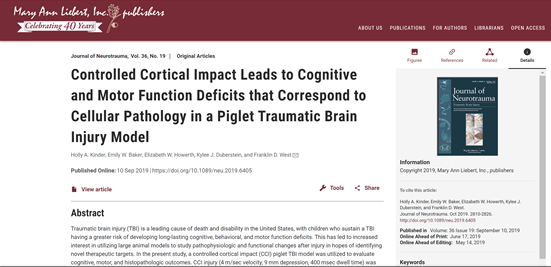Publications
-

The high morbidity and mortality rate of ischemic stroke in humans has led to the development of numerous animal models that replicate human stroke to further understand the underlying pathophysiology and to explore potential therapeutic interventions. Although promising therapeutics have been identified using these animal models, with most undergoing significant testing in rodent models, the…
Posted in: Publications -

See our publication “Traumatic Brain Injury Results in Dynamic Brain Structure Changes Leading to Acute and Chronic Motor Function Deficits in a Pediatric Piglet Model” in the Journal of Neurotrauma.
Posted in: Publications -

Traumatic brain injury (TBI) is a leading cause of death and disability in children. Pediatric TBI patients often suffer from crippling cognitive, emotional, and motor function deficits that have negative lifelong effects. The objective of this study was to longitudinally assess TBI pathophysiology using multi-parametric magnetic resonance imaging (MRI), gait analysis, and histological approaches in…
Posted in: Publications -

The Translational Neural Repair and Regeneration Laboratory announces the publication of a novel study in the Journal of Neurotrauma in which controlled cortical impact led to cognitive and motor function deficits that correspond to cellular pathology in a piglet traumatic brain injury model.
Posted in: Publications -

Traumatic brain injury (TBI) incidence has led to increased interest in utilizing large animal models to study pathophysiologic and functional changes after injury in hopes of identifying novel therapeutic targets. In the present study, a controlled cortical impact (CCI) piglet TBI model was utilized to evaluate cognitive, motor, and histopathologic outcomes.
Posted in: Publications -

Resting state functional MRI (fMRI) is an imaging method normally reserved for humans in order to analyze changes in brain activity. However, the Translational Neural Repair and Regeneration Laboratory has discovered that pig brains may be even better platforms than previously thought for the study of human neurological conditions. See our publication in Brain Connectivity
Posted in: Publications -

Neural stem cells (NSCs) have demonstrated multimodal therapeutic function for stroke, which is the leading cause of long-term disability and the second leading cause of death worldwide. In preclinical stroke models, NSCs have been shown to modulate inflammation, foster neuroplasticity and neural reorganization, promote angiogenesis, and act as a cellular replacement by differentiating into mature…
Posted in: Publications -

The heterogeneity of TBI coupled with the lack of comprehensive, standardized scales to adequately characterize multiple types of TBI remain to be major challenges facing effective therapeutic development. A systems level approach to TBI diagnosis through the use of metabolomics could lead to a better understanding of cellular changes post-TBI and potential therapeutic targets. In…
Posted in: Publications -

Traumatic brain injury (TBI) is a major contributor of long-term disability and a leading cause of death worldwide. A series of secondary injury cascades can contribute to cell death, tissue loss, and ultimately to the development of functional impairments. However, there are currently no effective therapeutic interventions that improve brain outcomes following TBI. As a…
Posted in: Publications -
Human neural stem cell extracellular vesicles improve recovery in a porcine model of ischemic stroke

Recent work from our group suggests that human neural stem cell-derived extracellular vesicle (NSC EV) treatment improves both tissue and sensorimotor function in a preclinical thromboembolic mouse model of stroke. In this study, NSC EVs were evaluated in a pig ischemic stroke model, where clinically relevant end points were used to assess recovery in a…
Posted in: Publications